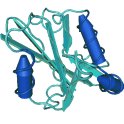
- Remove this product from my favorite's list.
- Add this product to my list of favorites.
Products
Newsletter
 |  |  |  |  |  |

Background: Phosphoinositide 3-kinases (PI3Ks) are lipid kinases that phosphorylate inositol phospholipids at the 3-position of the inositol head groups. The generated lipid second messengers serve as membrane docking sites for a variety of downstream effector proteins such as protein kinases, regulators of small GTPases, and scaffolding proteins. The class IA PI3Ks are heterodimers consisting of a p110 catalytic subunit and a smaller regulatory subunit with Src-homology 2 (SH2) domains (p85, p50 or p55). Upon activation by receptor tyrosine kinases, class IA PI3Ks use phosphatidylinositol 4,5-bisphosphate (PIP2) as their substrate to generate phosphatidylinositol 3,4,5-trisphosphate (PIP3), which recruits proteins to the membrane by binding to their pleckstrin homology (PH) domains. Thus, PKB is activated through recruitment to the membrane by PI3K lipid products and phosphorylation by 3́-phosphoinositide-dependent kinase-1 (PDK1). The class IB PI3K consists of one member, a heterodimer of p110γ and a regulatory p101 domain, which is activated by G-proteins βγ subunits following the stimulation of G-protein-coupled receptors. Two well-known and isoform-unselective PI3K inhibitors are the fungal metabolite wortmannin and LY294002.
Purified recombinant human PI3K expressed in Sf9 cells. Human PIK3CA, full length, amino acids M1-N1068, N-terminal HIS6 fusion protein with a Thrombin/TEV cleavage site and PIK3R1 (SV1:splice variant1) full length, amino acids M1-R724, N-terminal fused to a MYC-tag, Active form of PI3 kinase.
Protein concentration (Bradford with BSA as standard) : 0.38 mg/ml
Theoretical MW PIK3CA: 130,237 Da
Theoretical MW PIK3R1: 85,371 Da
Expression: Baculovirus infected Sf9 cells
Purification: Immobilized Metal Affinity Chromatography
Purity: > 90% by SDS PAGE
Specific activity: 15,189 U*/mg
* 1 Unit is defined as 1 picomole phosphate transferred to PIP2 per min
Entrez Gene ID: 5290/5295
UniProtKB: P42336/P27986
Ordering information: shipped on dry ice
Geering B1, Cutillas PR, Nock G, Gharbi SI, Vanhaesebroeck B. (2007) "Class IA phosphoinositide 3-kinases are obligate p85-p110 heterodimers."Proc Natl Acad Sci U S A. May 8;104(19):7809-14.
Vanhaesebroeck B1, Alessi DR. (2000) "The PI3K-PDK1 connection: more than just a road to PKB."Biochem J. Mar 15;346 Pt 3:561-76.
Hirsch E, Costa C, Ciraolo E. (2007) "Phosphoinositide 3-kinases as a common platform for multi-hormone signaling.” J Endocrinol. 194(2):243-56
Dong Z, Huang C, Ma WY. (1999) "PI-3 kinase in signal transduction, cell transformation, and as a target for chemoprevention of cancer.” Anticancer Res. 19(5A):3743-7.
Zhao JJ, Roberts TM. (2006) ”PI3 kinases in cancer: from oncogene artifact to leading cancer target." Sci STKE. 12;(365):pe52.
Osaki M, Oshimura M, Ito H. (2004) “ PI3K-Akt pathway: its functions and alterations in human.” Apoptosis9(6):667-76.
Welcome Login
Contact us
Follow us